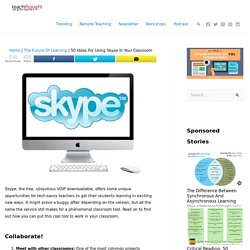

Vlogging is the new Blogging. Innovative Trends for the Future of Blogging. Scholarly Resources for Blogging in Education. What is Mobile Learning? More Than Just A Nice-To-Have. Sometimes simply referred to as mLearning, mobile learning is a broad term that refers to the process of learning via the internet or network using personal mobile devices such as smartphones, tablets, laptops, and digital notebooks.

Mobile learning has been around in one form or the other since the early 2000s but soared in popularity a few years ago because it allows students access to education anywhere and anytime, provided they have a mobile device. Basics Of Mobile Learning Mobile learning may be used to deliver microlearning content. It may include videos, animations, how-to guides, games, quizzes or assessments, etc.Social learning elements include a discussion forum, connecting with experts and peers, chat, and knowledge sharing.Offline mobile learning provides support to download the content and learn without access to the internet. You can track the learner's progress on their mobile device and sync the data to the Learning Management System when a connection is available. 1.
Social Learning. Offline Learning. Zoom Strategies for Education. How to Make Virtual Meetings More Interactive for Students - John Spencer. Chris montgomery unsplash. 50 Ideas For Using Skype In Your Classroom. Skype, the free, ubiquitous VOIP downloadable, offers some unique opportunities for tech-savvy teachers to get their students learning in exciting new ways.

It might prove a buggy affair depending on the version, but all the same the service still makes for a phenomenal classroom tool. Read on to find out how you can put this cool tool to work in your classroom. Collaborate! Meet with other classrooms: One of the most common projects educators utilize Skype for is setting up exchanges with classrooms around the world, usually for cultural exchange purposes or working together on a common assignment. Communicate! Connect! Art crits: Schedule time with professional artists and receive thorough crits about how to improve a piece. And here are the tools to help you do it! The Best Video Conferencing Software for 2021. What is Video Conferencing?

For many information-oriented workers, especially those in larger U.S. metro areas, working at home will likely become a long-term trend lasting into 2021 and beyond. A major contributor to the success of this strategy has been video conferencing. Much more than simply an occasional meeting and marketing tool, video conferencing has evolved into something that's become as ubiquitous as the phone for folks working from home.
To make it work, you'll be looking at different hardware components from the ones you've deployed in your conference rooms to make broad scale video-enabled telecommuting work, but the back-end service providers will remain similar. Additionally, video conferencing services usually offer more than just face-to-face interactions. All of those are fantastic communication aids for work-at-home scenarios, especially when viewed through a long-term lens. Growth of Popular Video Conferencing Systems During COVID 19, 2020.
20 Ideas for Video Conferencing with Students. Educators have access to LOTS of video conference platforms to use with students. Microsoft schools are likely to use Microsoft Teams video meetings or Skype. Google schools are going with Google Meet, and some schools are opting for Zoom and other tools. (This is a joint post between Ditch That Textbook and Infused Classroom – and also check out this great post on using Microsoft Teams by Matt Miller) The question most teachers have isn’t which platform to use. Using Breakout Rooms in Synchronous Online. 5 Video Conferencing Trends to Watch in 2020/2021. In just the last decade, we’ve seen video conferencing technology make tremendous strides in the workplace.

As remote work grew 159% between 2005 and 2017, video conferencing came along for the ride, with an estimated 58% of businesses now using video conferencing for their everyday operations. And as organizations around the world increasingly embrace distributed workforces, that momentum is only going to continue. What can we expect to see this year in terms of video conferencing innovations? Here are some trends to look out for: 1.
Tools like FaceTime and WhatsApp are some of the most widely used video calling tools in the consumer market today. Organizations (and their employees) are going to move towards video conferencing solutions that offer the best user experience. When it comes to video, organizations will move towards solutions that make video conferencing as easy as starting a FaceTime call and as feature-rich as a professional meeting. 2. 3. 4. 5. The future of meetings.